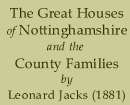Annesley
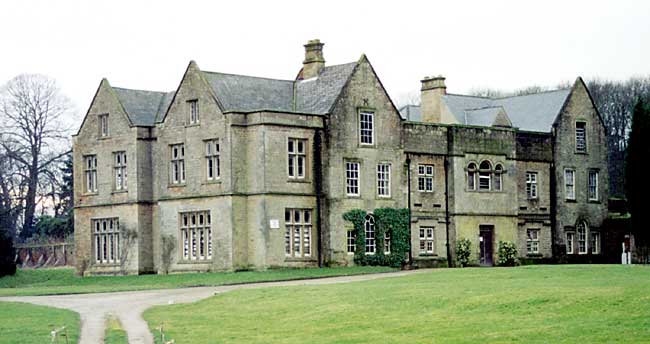
Annesley Hall, neglected and forlorn in 2003. The three storey, six bay hall has 13th century aisled hall origins but its current appearance is largely the result of large scale late 17th century extension and remodelling in 1838 (photo: Andrew Nicholson, 2003).
WHEN Mr. Musters is not angling for Dee salmon in Aberdeenshire, or engaged with rod and line upon the banks of some swirling Norwegian river, he will most probably be at his charming seat nestled amongst the trees of Annesley Park, for Wiverton sees but little of him, and Colwick less. Fifty years ago William Howitt, whose rural sketches are as familiar to some as those of Washington Irving and scarcely less interesting, visited Annesley Hall, and found it forsaken, neglected, and ghostly, by reason of the deep desolateness which possessed its grey walls, silent courtyard, and unkempt gardens.
O’er all there hung a shadow and a fear,
A sense of mystery the spirit daunted.
"This was once the abode of a prosperous old family," says the writer just mentioned, "but a blight and a sorrow have fallen here." A change has taken place at Annesley Hall since this description was written. It is now the abode of a "prosperous old family ;" of one of the largest landowners in the county ; a genuine sportsman, and a true gentleman, who now, having given up at a tolerably early age all active participation in the national sport, still takes the liveliest interest in everything concerning it. The desolation has long since been dispelled by the going to and fro of friends and dependents, the happy voices of children, who are rapidly growing up into manhood and womanhood, and by the sunshine of home life. But the memory of one sad incident will cling to Annesley so long as a single stone of that old hall stands.
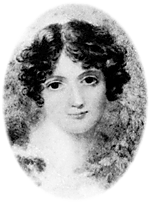
Mary Chaworth (1785-1832).
It was here that Lord Byron, always morbidly sensitive, but ere yet he had acquired that spirit of deep and settled melancholy, that love of self-accusation, which pervades much of his splendid poetry, bade farewell to Mary Chaworth. The spot where that last sad interview took place is still pointed out, and the spirit of Byron continues to haunt the seclusion of Annesley. "Had I married Miss Chaworth perhaps the whole tenor of my life would have been different," wrote the poet, and there was doubtless a deep meaning in the words. It was at Annesley that these two met as lovers ; it was there that the incident which inspired "The Dream," and which imparted a painful lustre to many of Lord Byron’s minor poems, occurred. Surely in this parting there was "an image of Death "—death of purest affection and tenderest attachment. If one is not sufficiently reminded of this interesting farewell scene by a mere sight of the grey and ivy-covered walls of Annesley, there are some small things treasured up in the old drawing-room—the most interesting room in the whole house—which serve to bring it to one’s memory. Here are preserved a couple of exquisite miniatures of Mary Chaworth herself, one painted when the subject was sixteen years of age, and the other after her marriage with Mr. John Musters. These are carefully placed in a glass case along with other little treasures. The young heiress must have been very beautiful, and from the look of that miniature face one would be inclined to say that the description which attributes to her a disposition the most amicable and attracting is not overdrawn. The features are small and beautifully rounded ; the expression is of exquisite sweetness.
Among the treasures of Annesley, and carefully preserved under a frame of glass, is the original of that pretty fragment written by Lord Byron after the marriage of Miss Chaworth—
Hills of Annesley! bleak and barren,
Where my thoughtless childhood strayed,
how the northern tempests warring,
Howl above thy tufted shade.
Now no more the hours beguiling,
Former favourite haunts I see,
Now no more my Mary smiling,
Makes ye seem a heaven to me.
The lines are legibly written in pencil with the signature of Lord Byron affixed. The document is in an excellent state of preservation. Of the other things which serve to remind one of Byron’s connection with this place is a modern picture by Mr. Ward, on one of the staircases, in which the poet, his handsome face bearing a look of anything but appreciation—he might be in just such a mood as that which possessed him when he wrote "The Waltz "—is looking through one of the windows of Annesley at some festivity which is going on inside. Through the partially open casement you can see that it is a dance, and probably the lady with so much floating colour about her is Mary Chaworth; equally probable it is that the red-coated squire who is treading the mazes of the waltz with her is her future husband.
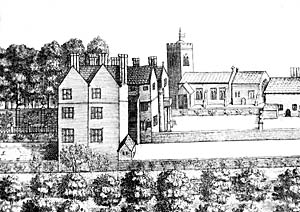
Annesley Hall and church as depicted in Thoroton's History of Nottinghamshire, published in 1677.
The Annesley estate came into the hands of Lord Chaworth, an Irish peer, by the marriage of one of his ancestors with Alice de Annesley, in the reign of Henry VI. Up to this time it had been held by the Annesleys, a family who gave the estate its present name. By the Chaworth-Musters marriage it passed into the hands of the Musters family, who assumed the additional name of Chaworth, and have held it since. Annesley then boasts great antiquity. Annesley Hall is, I should think, pretty much what it was in Byron’s time, the only addition to the building made by the present owner, being a wing built for family requirements. The stonework of the fine front is concealed by ivy of many, many years growth, and at the side over-looking the park a gigantic Virginia Creeper stretches wide-spreading, sturdy trailers bearing a profusion of dark red leaves in autumn. The approach to the hail is through a spacious park, with whose grand old trees and fine herd of deer many people who take their walks abroad are familiar. To get to the hall you have to pass through the portals of the "massy gate" which stood there in Byron’s day, and there is no cause to be afraid of a great handsome staghound which comes bounding towards you in playful curves. There are several of these beautiful hounds about the house, and they enjoy special privileges. The central hall is full of objects of interest. It has an unmistakeably ancient look. The furniture is old, the pictures on the walls are old, the deerskins which cover the floor are getting the worse for wear, the great jack boots which hang over the ancient fireplace, were made by no modern shoemaker, and the jerkin which is suspended beside them is evidently the work of a mediaeval tailor. The great boots and the old garment with the ancient weapons which are hung up here are said to have belonged to that eccentric outlaw whose existence has never yet been satisfactorily established—Robin Hood. On the walls are some family portraits representing ancestors, in the costumes which marked different periods, including Mr. Mundy Musters, of Colwick, who, so far as I know, did not distinguish himself in any particular line. In this apartment is kept the delicate bladed, finely tempered, handsomely mounted sword with which Sir John Byron is said to have killed Mr. Chaworth in a famous duel that has become a matter of history. The picture of that unfortunate gentleman, with his pale face and melancholy expression is hung in another part of the house. The strong quaint looking iron rails which guard the staircases, were not forged in any existing furnace. Ascending the staircase, and passing Ward’s picture of Lord Byron to which attention has already been called, and some more family portraits, one obtains access to the old drawing room. Two great staghounds are enjoying the comfort of this very comfortable apartment ; one is curled up in canine ease upon the sofa and the other is studying the figuring of the Dutch tiles which ornament a fireplace of gigantic proportions, and which on this chill autumn morning contains a bright, warm fire. The massive doorway contains one of those rare specimens of woodcarving which are sometimes to be met with in old country mansions, though there are few houses hereabouts that can boast such a specimen as this. It was executed by some clever carver in the reign of Charles II. at the instigation, it is said, of Lord Chaworth, the then lord of the manor. The ceiling is panneled and made dark with cornices of carved wood. The carving is evidently of the same date as that about the entrance. The huge fireplace with its Dutch tiles furnishes further evidence of the antiquity of this chamber, On one of the sides of the fireplace have been scratched some lines by a long dead Chaworth. They are so obliterated now as to be undecipherable except by the keenest eyes, but they have been committed to paper and preserved as a curiosity. On Christmas Day, 1669, "Poore Chaworth " thus pours out his sorrows in old English
Alas, I finde my poore heart will prove
Too small a vessell for oer flowing love,
Which makes me wish thine eyes so bright had never shinde,
Or that thou hadst been from thy cradle blinde. -- POORE CHAWORTH.
Then written, perhaps a little later, by the same hand, guided by scerener thoughts—
Juliana de la Fountaine
Is more worth than a goulde meuntaine,
The name above
Is her you love.—CHAWORTH.
There are in this old drawing room, besides a large and somewhat faded picture of John the Baptist preaching in the Wilderness, which occupies a considerable space over the fireplace, some family portraits in an excellent state of preservation, for the colours are almost as bright as when the pictures came from the easel. They include paintings of Lady Mary Byron who died in 1703, daughter of the Earl of Bridgwater, of Frances Lady Byron, daughter of William, Earl of Portland. The beautiful little collection of miniatures, the most interesting of which I have already mentioned, are carefully preserved together with other small things each possessing some particular interest of its own. The modern drawing-room down stairs is a very different apartment. It is furnished and fitted as the reception room of a great country house should be ; with luxurious settees, and chairs and couches set upon a downy carpet. Its broad casement commands a view of one of the prettiest bits of park scenery in England. Such delightful grassy undulations; hills rising gently in the distance, grand old trees, the growth of centuries, and the gleam of water down in the hollow. There are some water colours of Eastern cities on the wall of the drawing-room, a portrait of Lord Chesterfield, the man of fashion and celebrated wit, in court dress, and one of Lady Howe which bears the one just named close company. The dining-room is a large and handsome apartment, containing several hunting pictures the figures in which are family portraits. The large one over the mantelpiece shows the present owner’s grandfather on horseback, with two other gentlemen fully equipped for the chase, and the dogs look anxious to be off. ln the corner near the window is the portrait of Mr. John Musters, a handsome man, who died in 1842 at the early age of thirty-four, and near the door one’s attention is called to the portrait of a lady—very beautiful she must have been too, who by a single game of cards won a fine estate of several thousand productive acres.
The room is lofty and light as are all the other principle rooms in this old house. The speediest way of getting to the gardens is by traversing a grand old flagged terrace, flanked all along by a high wall covered with creeping plants which grow in the sweetest confusion. Here it is said Lord Byron used to practice pistol firing, probably to the terror of Miss Chaworth. The terrace is ornamented by a balcony of stone, coloured in many places by lichens and mosses, and bearing in the centre of its length a stone urn on which is carved the escutcheon of the Chaworths. Two broad flights of steps terminating the terrace, bring you into the gardens where there are little paths leading into the most delicious solitudes. It is worth a visit to Annesley to be allowed to wander amongst the splendid shrubs which so thickly stud this portion of the estate ; masses of bright green—sturdy bay, and lusty laurels, which latter look like so many leafy wigwams. It is very quiet in these garden solitudes, on this still October morning, when the only sound to be heard is the crackling of the crisp reddish brown leaves, which strew the paths, and the occasional shrilly note of the robin.
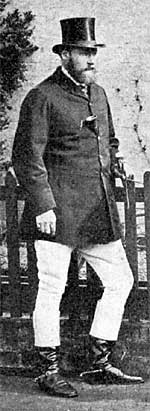
John Chaworth Musters.
It is a fine old place this Annesley Hall, the principal seat of Mr. John Chaworth Musters, the owner of 8,000 broad acres in Nottinghamshire, and everywhere deservedly popular. A thorough sportsman and and an English gentleman; that is how I should describe Mr. Musters, of Annesley Park. One of the best riders across country he has been in his day, and every sportsman in the county was sorry enough when he withdrew from the chase, now some years ago, as the tenant farmers of Nottinghamshire felt sorry when he severed his active connection with the Chamber of Agriculture, because he could not conscientiously lend himself to a course which that body proposed to pursue. As master of the Quorn, a post which none but a wealthy man and a sportsman versed in every movement of the chase could possibly undertake, with any hope of success, he won that peculiar and enviable popularity which attaches to a successful master of foxhounds, and later as master of the South Nottinghamshiire, a pack which, under his sway, became scarcely less famous than the Leicestershire one, he gained the esteem of every lover of the hunt in the county.
The Annesley property as we have seen, came into the family by marriage. The Colwick estate, on which the family so long resided, was purchased by Sir John Musters, of Hornsey, who was knighted at Whitehall in 1663. Wiverton Hall, which also belongs to Mr. Musters, was formerly a house of considerable size and importance, was included in the vast possessions of the Chaworths. It became their property in the reign of Edward III., and remained with the family until the Chaworth-Musters marriage, when it went to the Musters’ together with all the other extensive possessions of the Chaworths.
